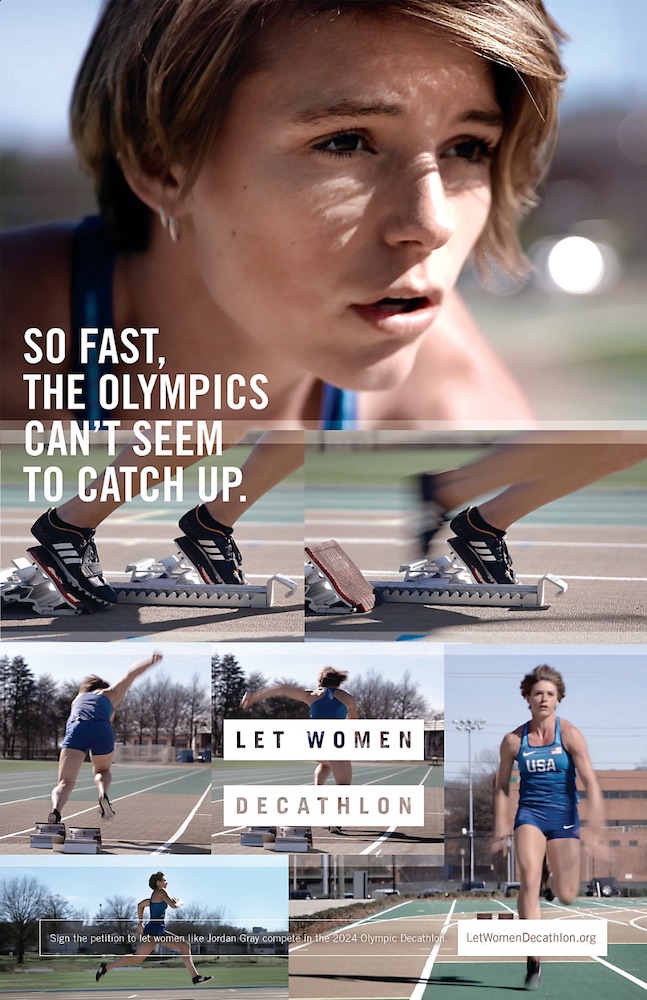Women started participating in combined events quite early. Already in the 1930 Women's World Games a triathlon appeared in the program. It comprised 100 m, high jump and javelin throw. And K. Hitomi, obtained the silver medal in the event (despite being a so-so high jumper).
Speaking of javelin throw, I discovered some astonishing photos while perusing old archives. It is clear that in the 1922 and 1926 World Games, as well as in the 1924 women's Olympiad, both the shot put and the javelin throw were two-handed, i.e. the classification was obtained on the basis of the addition of throws with the right and with the left hands. But what I did not now is that, at that time, the women were throwing in what was considered the "free style". The photo below is that of Francesca Pianzola who won the event in 1922 and the style is unambiguously not the classical, "greek" style. (Many more photos of that period do exist, showing women throwing in that style).
The classification of the 1930 triathlon was most probably based on the german tables, where the top score corresponded to 100 points.
By 1934 the triathlon was replaced by a pentathlon, comprising 100 m, high jump, long jump, javelin and shot put. The world record established in 1934 was homologated in 1938 and in 1946 the pentathlon appeared in the IAAF rules for women's athletics. This did not settle the matter and the various countries continued organising combined events with rules and scoring varying from country to country. The pentathlon was initially organised over two days but in the 70s it became the rule to complete it in one day. (The latter is true for the indoor pentathlon today, which, I believe adds to the event's appeal). Long jump was always one of the events and almost always high jump as well. Hurdles were introduced in 1949 and persisted thereafter. Not astonishingly (see my post on the events of the 1928 Olympiad), the 800 m, which was initially part of the pentathlon, disappeared after 1940.
But it soon became clear that the pentathlon was somewhat too light an event, in comparison with the decathlon. So some countries experimented with octathlon and even enneathlon (but with track events being 100, 200 and 800 m). And finally when it was decided to revamp the women's combined events, the IAAF hierarchy (who are probably always convinced of women's inferiority, while talking about parity and equality) decided to force upon women an amputated combined event in the form of the heptathlon.
I have written, time and again, in support of a decathlon for women. Unfortunately I am afraid that this may never happen, despite the efforts of the great female decathlete, J. Gray. Women are also responsible for this, the heptathlete elite being reluctant to relinquish their supremacy by venturing into the unknown (and admittedly perilous) terrain of the decathlon.
But let us go back to scoring. Already in the 1920s Germany and USSR had developed scoring tables, and used them for the national pentathlon championships. The german tables were 100-point ones and were used in the women's World Games in 1930 and 1934. There were no combined events neither in the 1938 nor in the 1946 European championships, the pentathlon (Shot put, high jump, 200 m, 80 m hurdles and long jump) making its appearance in the 1950 European's (but had to wait till 1964, before becoming an olympic event). The scoring was based on french tables which were globally progressive (but which, for practical reasons, were piecewise linear).
At the beginning of the 50s it became apparent that women's athletics could not be ignored any more. Much to the disappointment of the IOC president A. Brundage, women would continue competing in sports. And thus it became necessary to produce scoring tables for women. A. Jörbeck was by that time the person taking care of scoring in the IAAF and, having discovered the theories of K. Ulbrich, he applied them on the scoring tables for women. The tables were accepted in 1954 and lasted for 30 years.
In the World Athletics history of scoring one encounters a rather ambiguous language when it comes to Jörbeck. On the one hand they laud him stating that "he applied Ulbrich's theories with great judgement and moderation". But then they point out the flaw in Ulbrich's approach and segue into: "It is a measure of Jörbeck's skill...that this weakness has lain dormant for so many years". Be that as it may, combined events, both for men and women, did suffer from the IAAF misguided decisions for a full quarter century.
Before ending this post I would like to make clear that it is not only the women's heptathlon that I do not like. I also find men's indoor heptathlon an unnatural event (which is totally unbalanced with three jumps and one throw). In fact the ideal indoor combined event for men would be a one-day pentathlon just as in the case of women. And since I like parity, either have the men run a 800 m or increase the distance of the women's final event to 1000 m (with a slight preference for the latter). But, of course, one can only dream.



No comments:
Post a Comment